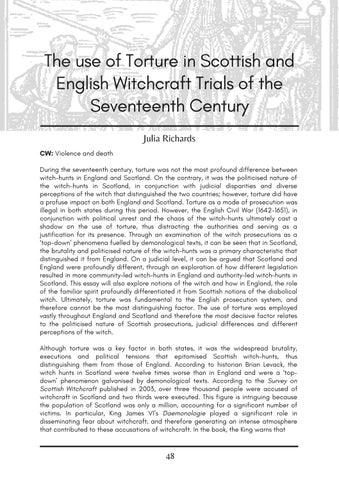The use of Torture in Scottish and English Witchcraft Trials of the Seventeenth Century Julia Richards CW: Violence and death During the seventeenth century, torture was not the most profound difference between witch-hunts in England and Scotland. On the contrary, it was the politicised nature of the
witch-hunts
in
Scotland,
in
conjunction
with
judicial
disparities
and
diverse
perceptions of the witch that distinguished the two countries; however, torture did have a profuse impact on both England and Scotland. Torture as a mode of prosecution was illegal in both states during this period. However, the English Civil War (1642-1651), in conjunction with political unrest and the chaos of the witch-hunts ultimately cast a shadow
on
the
use
of
torture,
thus
distracting
the
authorities
and
serving
as
a
justification for its presence. Through an examination of the witch prosecutions as a ‘top-down’ phenomena fuelled by demonological texts, it can be seen that in Scotland, the brutality and politicised nature of the witch-hunts was a primary characteristic that distinguished it from England. On a judicial level, it can be argued that Scotland and England were profoundly different, through an exploration of how different legislation resulted in more community-led witch-hunts in England and authority-led witch-hunts in Scotland. This essay will also explore notions of the witch and how in England, the role of the familiar spirit profoundly differentiated it from Scottish notions of the diabolical witch.
Ultimately,
torture
was
fundamental
to
the
English
prosecution
system,
and
therefore cannot be the most distinguishing factor. The use of torture was employed vastly throughout England and Scotland and therefore the most decisive factor relates to the politicised nature of Scottish prosecutions, judicial differences and different perceptions of the witch.
Although torture was a key factor in both states, it was the widespread brutality, executions
and
political
tensions
that
epitomised
Scottish
witch-hunts,
thus
distinguishing them from those of England. According to historian Brian Levack, the witch hunts in Scotland were twelve times worse than in England and were a ‘topdown’ phenomenon galvanised by demonological texts. According to the Survey on Scottish Witchcraft published in 2003, over three thousand people were accused of witchcraft in Scotland and two thirds were executed. This figure is intriguing because the population of Scotland was only a million, accounting for a significant number of victims.
In
particular,
King
James
VI’s
Daemonologie
played
a
significant
role
in
disseminating fear about witchcraft, and therefore generating an intense atmosphere that contributed to these accusations of witchcraft. In the book, the King warns that
48
